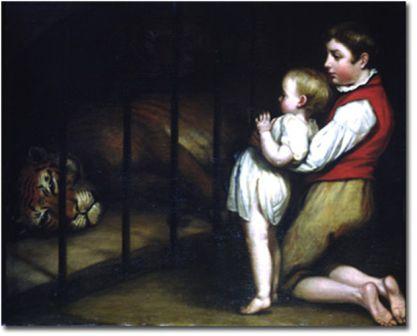Have you ever seen a lion in a museum? In startling footage of the National Museum of Wildlife Art, a live male African lion pads through the galleries. He wanders calmly past paintings and sculptures, nosing through carpeted galleries, stopping once to roar. Not the outdoors, not a cage, not an open vista--nothing to eat.
This strange juxtaposition of captive wildlife and artworks can be seen on a video, Wild at HeART, produced by SavaFilm. It raises a number of questions about people, art, and wildlife. How do we see animals, and how do they see us? What determines the ways that we portray animals in art? Is there something fundamental about the human habit of portraying animals?
James Northcote's 1816 portrayal of two children peering into a tiger's cage is another starting point for exploration of these questions. The painting is more complex than it appears to be at first glance. Behind the tiger in the foreground of the cage stands another, more threatening in visage.

In the rage for authenticity, many people favor direct experience with wildlife--but it is almost impossible to break the cultural frames that we create for that experience. It is one thing to view lions, polar bears, and sharks in paintings or films, quite another to get up close and personal. The recent and unfortunate death of a Sea World trainer is only one in a continuing number of human encounters with animals where expectations about animal behavior fail, even within a defined context. People continue to express severe misgivings about holding animals in confined spaces under any circumstance.
Painters, sculptors, photographers, filmmakers stretch beyond most of us to create images of the animals they portray. Artist's stories about the experience of getting the image expand the action--the narrow escape from a charging elephant, the unexpected closeness of a mountain lion, the intensity of a wolf's gaze.
At the same time, we wonder about what the world will be like without animals. "It's a beetle," says the father, in a singularly hopeful scene from The Road, based on the novel by Cormac McCarthy. Father and son regard the small creature picked up by the son, whereupon the beetle buzzes off into the blasted branches of a tree. In the apocalyptic world of The Road, all animals are declared dead, but they remain present despite the destruction: a mounted deer head on the office wall of a destroyed bank, the buzzing beetle, and a puzzled-looking dog--the final member of the family where the boy ends up.
The mounted deer head is a grim reminder that we have often valued things more after they are dead and gone than we did when they were alive. But for all the framing and predictions and opinionating, artists and wildlife persist. Carl Akeley, James Lippitt Clark, and other artists who pioneered the use of dioramas in museums over a hundred years ago worked in the expectation that many of the animals they portrayed would one day be extinct. I like to think that due to their labors some wildlife has survived. I also hope, as I survey the enormous number of animal and wildlife photographs and videos on the Internet, that more people will recognize the sketchers, painters, sculptors, and other artists who portrayed animals in the wild when zoos and cameras were not available to them.